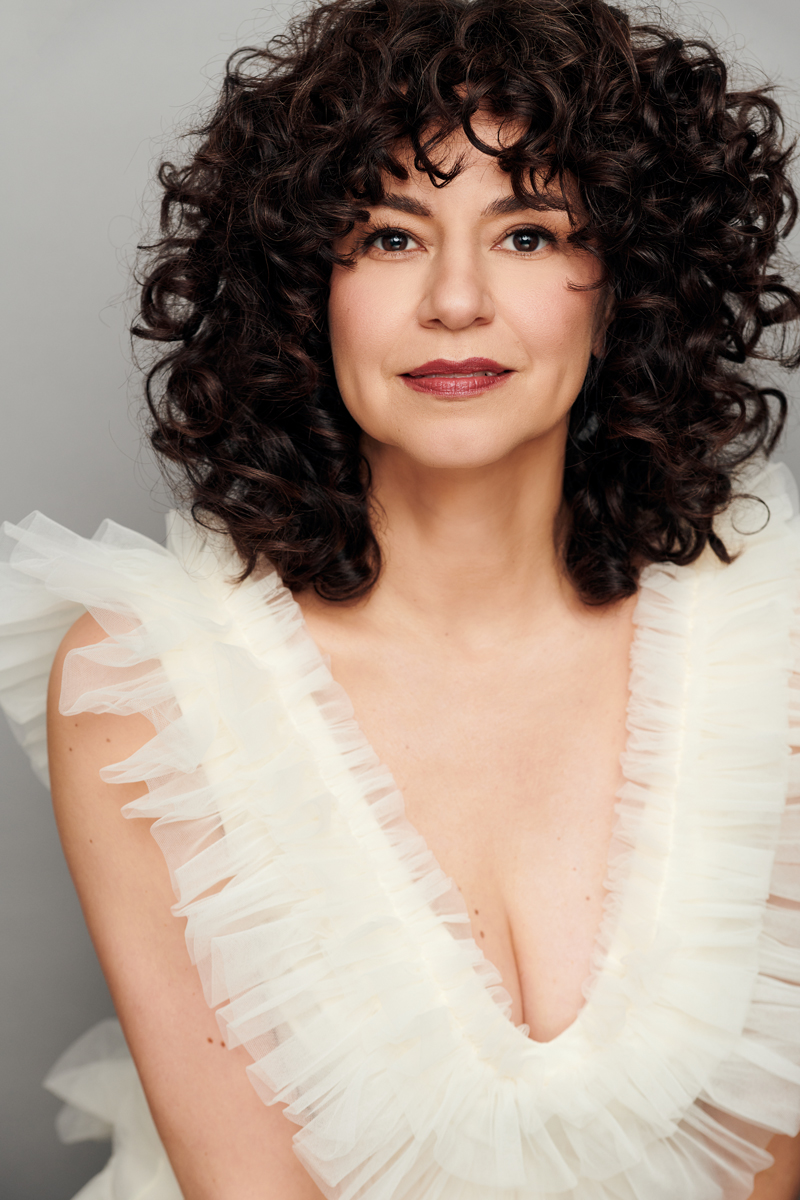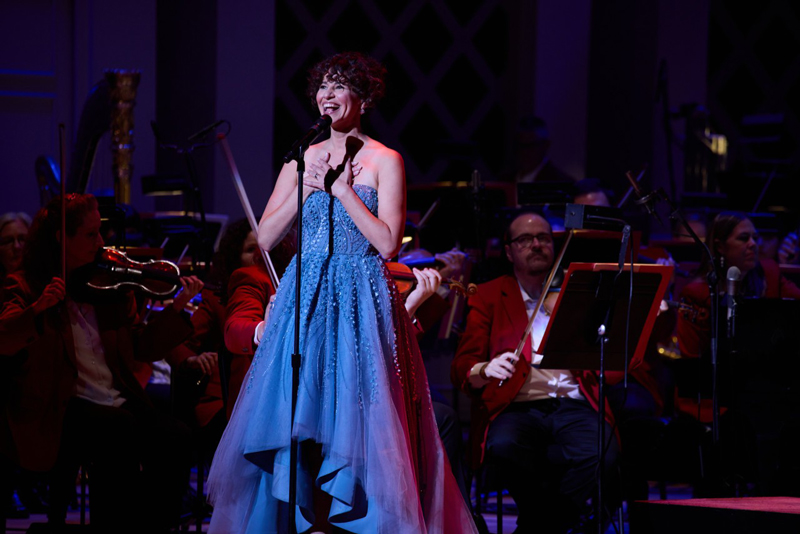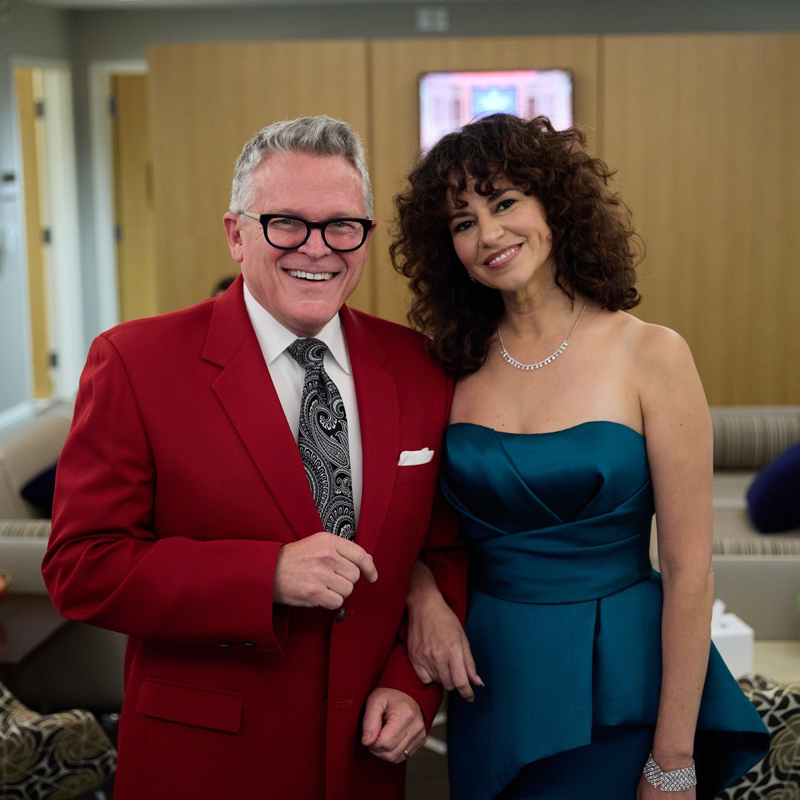
by Dr. Scot Buzza
“We begin fearless…”
For actor-singer Mandy Gonzalez, “fearless” is an important word. It shows up in several of her biggest creative projects: the title of her debut solo album and its title track, composed for her by Lin-Manuel Miranda; the name of her #FearlessSquad social media community for isolated teens; and, most recently, the name of her series of young adult novels. But fearlessness is also a deeply personal notion, rooted in family history, starting with her parents’ courtship.
As a teenager, her mother Robin was forbidden to join the Peace Corps, so instead she supported American troops overseas as a pen pal, sending letters of encouragement to GIs serving in the Vietnam War who had nobody back home to write to them. One of those was a 19-year-old soldier named Paul Gonzalez. The two strangers began corresponding, and after his service ended, Gonzalez took a gamble, set out to find the woman who had enchanted him, and eventually showed up on Robin’s doorstep. They quickly fell in love, much to the alarm of both her Jewish American parents and his Mexican American family. They married, started a family, and have remained together for more than 50 years.
For Mandy Gonzalez, her parents’ story is one of tenacity, perseverance and strength. Her father worked three different jobs while struggling with PTSD. Her mother worked as well, adjusting her schedule to be home with the kids by 3 p.m. They insulated Mandy and her siblings from tensions between their Jewish and Mexican cultures, and she enjoyed close relationships with both her bubbe (“grandmother” in Yiddish) as well as her abuelita (“grandmother” in Spanish).

“We crawl, we walk, we run…”
It was Mandy’s bubbe who first cultivated her love of musical theatre and encouraged her musical talent. She introduced her young granddaughter to recordings of classic torch singers such as Eydie Gormé, Ethel Merman and Judy Garland, often taking her to performances at the nearby Showboat Dinner Theatre. One evening after a production of Man of La Mancha, she took Mandy backstage to meet the actress playing Aldonza. That actress later became Mandy’s first singing teacher. An onstage role for Mandy as the youngest daughter in the Showboat production of Fiddler on the Roof followed, and she soon began performing locally, taking dance classes and attending theatre camps. Music and theatre quickly became the center of her life. At age 12, she sang a torch song rendition of “Birth of the Blues” on the American television show Star Search and performed continually in high school and community theatre productions.
After graduation, she enrolled at the California Institute of the Arts, only to leave after a year when she won a job singing backup for Bette Midler on her Millenium Tour. She then moved to New York City with her then-boyfriend/now-husband and began auditioning while working three jobs. She didn’t have an agent yet, so she went to every open call audition for six months, standing in line behind hundreds of other hopefuls, waiting for the chance to be seen.
At that point, the balance of Jewish and Latin identities that Mandy had taken for granted began to clash with her dreams of performing. “When you grow up in two different cultures,” she says, “you have so many people that try to fit you in some kind of box. When I was younger it didn’t affect me; you just sang. Then when I started to do this professionally, I heard, ‘I don’t know if you can play this part because you’re ethnic. Your skin is too light, your skin is too dark.’ I had to figure out where it was that I felt I belonged.”
“Until the world puts up a wall…”
American Musical Theatre has historically been on the cutting edge of issues of race, class, gender and, in a sense, identity. Productions as far back as Showboat and South Pacific have challenged audiences by posing difficult questions in a way that no other medium has been able to do. However, the same theatre industry that supports those groundbreaking productions has itself been problematic in its resistance to fair opportunity and representation. For many decades, Latin and Hispanic portrayals onstage were limited to a handful of stock characters such as seductresses (Lola in Damn Yankees) and working drudges (Julio in Paint Your Wagon).
West Side Story in 1957 was a step in the right direction, but only a tiny one. The story was daring for its time: it centered on two rival street gangs, one white and one Puerto Rican, although the narrative tilted strongly toward the Caucasians. The Puerto Rican characterizations were watered down, whitewashed and coated with a phony, generic Latinity. Leonard Bernstein’s musical score, brilliant though it is, lumped together genres such as mambo, huapango, paso doble, samba and cha-cha-cha, creating a pastiche of Cuban, Mexican and Brazilian cultures with no concern for authenticity, under the assumption that nobody would know the difference—not white audiences, anyway.
The irony that a quintessential “American” love story about Latin Americans should be written by a team of four gay, Jewish New Yorkers did not escape book writer Arthur Laurents, who would revise the production several times in later years in an attempt to restore some degree of truthfulness.
The casting in West Side Story highlighted a much more blatant problem. Of the original Broadway and West End productions, only one of the leads, Chita Rivera, was Latina. The others were Caucasian performers with Ricky Ricardo accents and dark makeup, a common practice at the time known as “brownface.” Hollywood did no better: the 1961 film version of West Side Story is rebuked today because even Rita Moreno and the naturally olive-skinned George Chakiris, a Cincinnati native of Greek descent, were buried under dark greasepaint that looks as though it were applied with a fire hose.
“They put us in boxes…”
These same racial dynamics were a persistent undertow in the professional world that Mandy Gonzalez entered when she arrived in New York at age 22. “I had an agent who felt that the name Gonzalez would hinder me, would not allow me to play the kind of parts I wanted to play,” she recalls. “I thought of the actress Vicki Carr, with two ‘r’s, who was Mexican as well, and so I was going to be Mandy Carr. But then I thought about my parents and their fearlessness, and I wanted their name to be in lights. So I told the agent, ‘it’s not going to be Carr with two ‘r’s, it’s ‘Gonzalez’ with two ‘z’s.’”
Eventually her months of auditions paid off and she won a role in the off-Broadway cast of Eli's Comin', giving a performance that won her an Obie Award and caught the attention of Disney Theatrical Productions. In 2001, Mandy made her Broadway debut as the standby to Princess Amneris in Aida, a role she later took on full-time to critical acclaim.
In 2002, Mandy won the role of Sarah, the female romantic lead in the Broadway adaptation of Dance of the Vampires, a German-language import that was heavily rewritten to feature Michael Crawford of The Phantom of the Opera fame. Audiences loved her performance, but critics savaged the production and once again Mandy found herself put into a box. One critic in particular, already notorious for his racist, misogynistic and homophobic reviews, disparaged her for her physical appearance. But production photos of the stunning 24-year-old leading lady with legs up to her armpits, cheekbones for days, and expressive, dark eyes tell the full story: she didn’t look Aryan enough for his taste.
Mandy had returned to Aida and then moved on to her next Broadway production, Lennon, when a request came to her from an unknown composer about his new project. That production was In the Heights, and the composer was Lin-Manuel Miranda. The score itself was a tour de force that brilliantly and effortlessly transitioned between salsa, merengue, samba, rap, hip-hop, soul, R&B and traditional musical theatre genres with an authenticity not seen before. Furthermore, the script, the storylines, the set design, the costumes and the choreography all integrated genuine Latin and Hispanic national idioms and symbols, without ever homogenizing them into the ersatz Latinity that had permeated West Side Story.
“I felt like I was home,” Mandy remembers. “Up until that point, you were the only one in the show that was of Latino descent. In this show it was all of us, from all different backgrounds, different cultures. It felt like for the first time we were seen—but not seen as we had stereotypically been seen. There was just such a sense of celebration.”
In both the off-Broadway and the subsequent Broadway production of In the Heights, Mandy Gonzalez created a character unlike any that had been seen on stage previously: Nina Rosario, a bright first-generation college student tormented by the pressure to succeed and wracked with doubts about where she fits into her community. The show won four Tony Awards in 2008, including for Best Musical, and the cast won the 2008 Drama Desk Award for Best Ensemble Performance.
For Mandy, other successes soon followed. In 2010, she took over the role of Elphaba in the Broadway production of Wicked, and, in 2016, she joined the Broadway cast of Hamilton as Angelica Schuyler, a role she performed for nearly six years. In October 2019, when Mandy was diagnosed with breast cancer, she continued doing eight shows a week while simultaneously undergoing chemotherapy and radiation therapy—fearless, indeed.

“As we grow and make this place our own…”
Mandy Gonzalez, once told she would never play leading roles, is currently performing as Norma Desmond in the Broadway revival of Sunset Boulevard. Is this a sign that the theatre industry has taken a step forward in the way professional productions are cast?
Mandy says, “There has been a big change, definitely. Hamilton has been a big source of change in how shows are cast, to give everybody the opportunity to come in for a role if they are the right person. There have been so many shows that I have never gone in for, like Sunset Boulevard, or like these roles which are not typically cast with women of color. It is visionaries like Jamie Lloyd, who say, ‘let’s get the best person for the part.’ I think that’s what we all hope for.”
When she founded her #FearlessSquad social media community, she could not have predicted the thousands of people it would reach. But Mandy Gonzalez’s story is not only about lifting others up; it’s also about tenacity and resilience: “I had no idea that my own life would take so many turns, and that I would need that word throughout my own journey. It’s about feeling the fear and doing it anyway.”
I held your hand in mine and together we changed the world.
We help each other when we fall.
We embrace our differences.
We look for the good.
We dream big.
And together, we are fearless.
(Fearless Squad slogan)